Episode Transcript
[00:00:11] Speaker A: A big attack on the hospital for child and mother killed children. At the moment.
[00:01:12] Speaker B: We have here and we are creating dance performance.
So name of our piece it's.
And it based on works of Friedrich Nietzsche. And also we are exploring cyclicality of the universe in this piece.
So I would like to say that dancing in Ukraine before the full scale invasion was at the same time quite young. And sometimes you can see a lot of like student work, naive work. But we don't have any dance institution, like no dance institution at all. So we don't have support from government, from institution for contemporary dancers. And we have these two things that it's. Or students from university or it's kind of underground wild dancers who. Who are extremely talented, who can do really cool pieces, but they never appear on the big stage because we don't have this link support for them we didn't have. Now actually it's better.
But every time when in Europe I watch dance performance during dance festival somewhere I'm thinking why Ukrainian dancers are not here. They deserve. They can be here and they have unique style. You can really feel it. You can really see that this difference as you don't have support, you can survive only if you're really strong, only if you have really unique and powerful style and you're really great in your technique etc.
So it's like in the forest or somewhere in wild nature. And people they just creating their unique styles and they are so good at it. And I also have background of the street dance, so I'm talking and we don't have borders between. We don't have such big borders between contemporary and street dancers. Like people try to unite because they are in this difficult conditions and they are trying to create something by themselves. And people are creating amazing festivals, performances, etc, just by themselves, without any support.
[00:04:41] Speaker A: So as I said, I work on the performance about Ukrainian maternity and my idea. I work also with dramaturk, with set designer and with composer. And altogether we try to create such a bright image of what Ukrainian maternity is and why does it differ from other maternities experience. And for now I have some features of it that I could figure out. For example, it's this connection to war hidden or obvious connection in different times. The second one it's this.
I try to use movements of Ukrainian ethnic dance and it has. I work alone, so there is no baby on the stage. And it's a solo performance, but it's a baby in the video.
My dance vocabulary, it is most of all, of course contemporary dance, but it's Also ethnic movements, movements from ethnic dance. And it's that I use them in different context and in different variations and sometimes in different performing to express either either this spirit, Ukrainian spirit, or sometimes irony. Because the real Ukrainian ethnic dance was actually deformed in Soviet time and it was adjusted to Soviet ideology. And it had already different scent, different external marks of it. Yeah, some costume, some bride. And we have even special word for this period for Ukrainian tradition, for working with Ukrainian tradition of this period. This word is sharovarshina. So. And it's something sharovary. These are these big, so wide Ukrainian trousers that were used, that were made of such very bright color, especially for stage. And they were used in Ukrainian dances to show this as if peculiarity of Ukraine, but really without any going in death. What. What is happening in Ukraine. And now I'm somehow laughing at. So say showing this ironical attitude to this period and showing this difference. And now for ourselves in. In the dance, it's also. I hope it would be. It will be the trend. And we also worked on it with my students. We rediscover that this authentic Ukrainian dance, ethnic dance for ourselves. And some movements are also inserted in my dance vocabulary here.
[00:08:08] Speaker B: Revolution started in Ukraine because we wanted to be part of Europe and Russia didn't want that. And so we still paying for that. We're still paying and fighting for our freedom and for this chance to be part of Europe. And during all history of Ukraine, we were much closer to Europe than to Russia.
We were much closer to Europe than to Russia.


